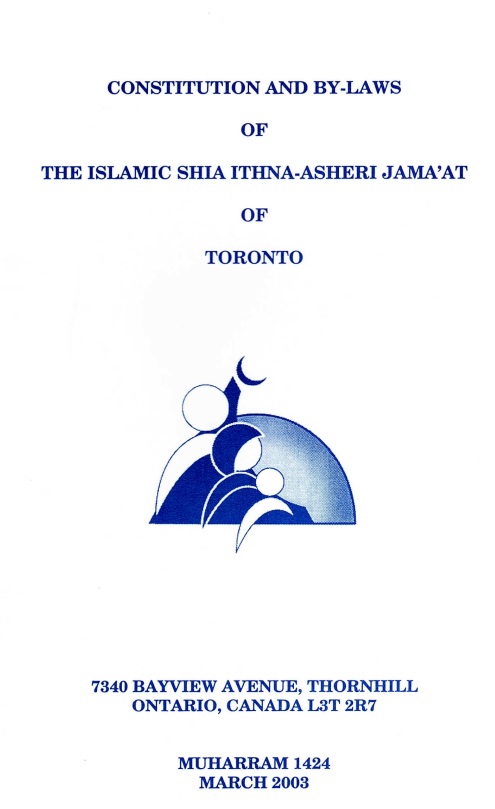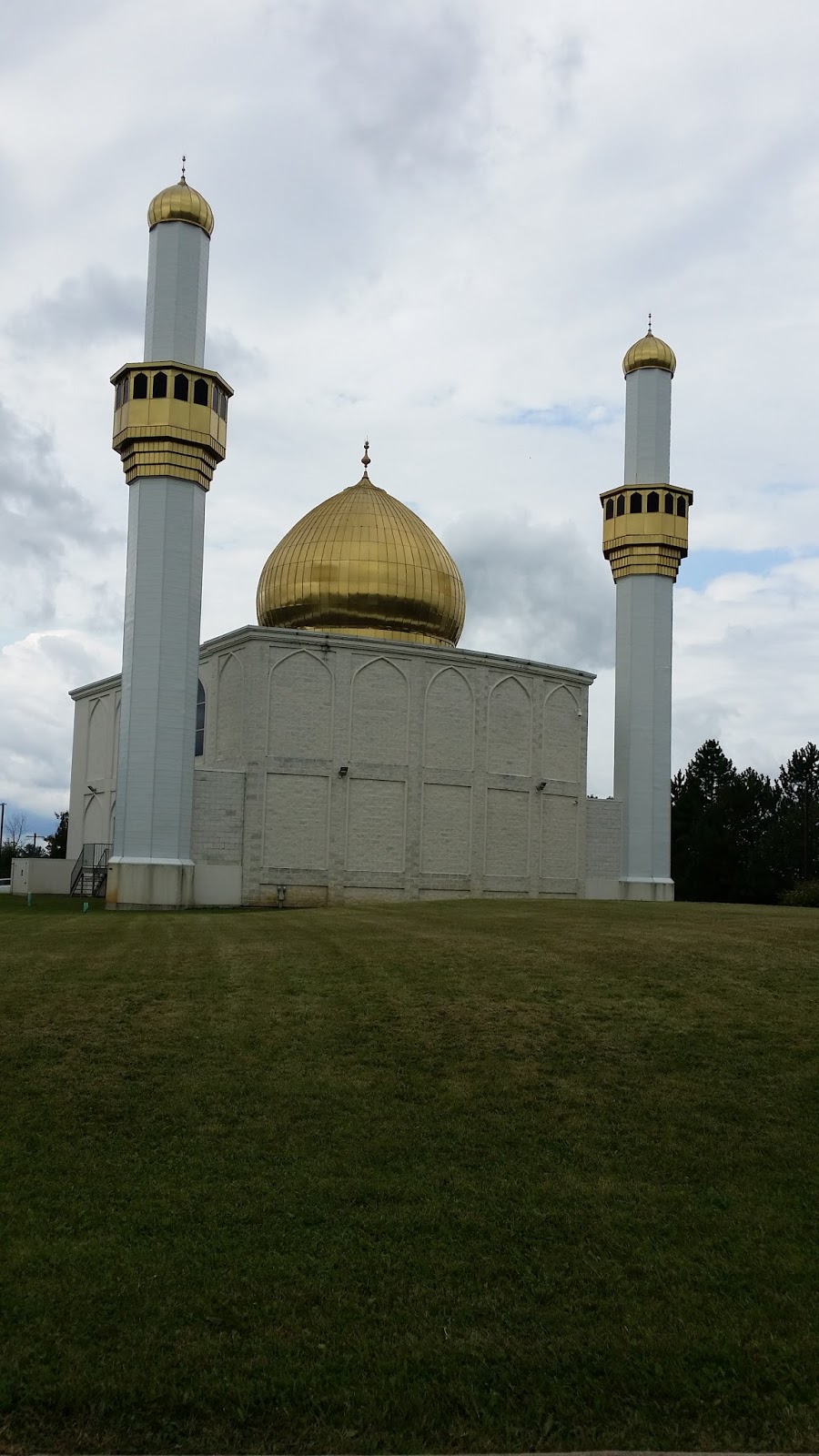“After a difficulty, Allah will soon grant relief”. Quran 65:7
The 2000’s were characterized by global and local events which caused much stress to our community. In the wake of the infamous 9/11 attacks in the USA, the rise of Islamophobia in civic society, the media and elsewhere affected the way that others viewed us as a faith-based community. Thankfully, our neighbours, friends and both local and provincial governments supported us and provided protection when needed.
The middle of this decade was fraught with difficulties related to the delayed start of construction of the Jaffari Community Centre, which was finally completed in 2009. We also experienced much happiness when the Masumeen Islamic Centre opened in 2003.
The community in the West-End
In February 2000 a conditional purchase agreement was reached to buy a parcel of land at 7580 Kennedy Rd in Brampton. A proposal to build a centre of worship for our community was submitted to Brampton City Council. Work to design the new centre began in April 2000. Later in September a public meeting with the local council and residents took place. The president of Toronto Jamaat Ali Raza Rajani, the Chair of the West-End community’s Management Team Murtaza Panju and their teams worked jointly to secure re-zoning permission for the land to be used as a place of worship. Issues that had arisen were handled. Then the community had to raise $650,00 for construction to begin. In April 2001 approval from the council’s building committee was secured and thereafter zoning and site plan approvals too.
In March 2002 a ground-breaking ceremony took place in front of hundreds of members of the West-End community and others. Later that year in November building construction began. On October 19th, 2003 a grand opening ceremony accompanied by much celebration was held at the new centre, called “Masumeen Islamic Centre” (MIC). The West-End community finally had a property of their own in which to congregate and worship. Their dream was finally realised, Alhamdulliah!
In 2008, based on an agreement between the ISIJ of Toronto, the MIC management committee led by Bashir Muraj, the West Madressah committees, Wali-ul-Asr Learning Institute and ISSC, an Islamic school called Wali-ul-Asr Learning Institute was established in the Masumeen Islamic Centre’s building.
The community in Toronto
In 2001 the CRC’s review of the Constitution and By Laws of the ISIJ of Toronto was completed with recommendations. On June 16th a resolution to amend the current constitution was tabled. It proposed three key changes: –
- A NEW COMPOSITION OF THE EXECUTIVE COMMITTEE, TO HENCEFORTH INCLUDE THREE ELECTED MEMBERS. THESE NEW POSITIONS WERE CREATED TO PROVIDE MUCH-NEEDED CAPACITY TO THE SIX EXISTING ROLES OF PRESIDENT, VICE PRESIDENT, HON. SECRETARY, HON. TREASURER, MUKHI AND CHAIRLADY.
- REPLACEMENT OF THE PLANNING BOARD WITH A NEW SUB-COMMITTEE.
- THE ELECTION OF THE JAMAAT’S TRUSTEES. (HITHERTO THEY HAD BEEN APPOINTED)
The resolution passed and the new constitution was published in March 2003. It replaced the constitution of 1993 and guided the operations and decisions of the Jamaat as a charitable organization for the next thirteen years until 2016, when the ISIJ of Toronto incorporated itself as a non-profit charitable entity.

In 2005 a resolution was passed at the AGM to purchase 500 burial plots at the recently opened Al-Hussain Foundation property in Markham.

From 1999 to 2003 construction at 9000 Bathurst St. continued and approximately 20 percent of the work was completed. The framework of the building of the new Community Centre was erected. On June 1st, 2001, the Site Plan for the Jaffari Village project was formally approved at the City of Vaughan. On 13th Rajab/September 30th, 2001 (the birth anniversary of Imam Ali (A.S.), a ground-breaking ceremony for the new Islamic Education and Community Centre was performed by Resident Alim, Maulana Sayyid Muhammad Rizvi. The construction phase of JCC started on June 15th, 2002
On July 27th, 2003 a Special General Meeting (SGM) was held to update the community on the progress of the project. Certain design changes were proposed, and the EC was mandated by the General Body to review the overall design and report back. At a subsequent SGM on September 21st, 2001 the General Body accepted the recommendation of the EC to proceed with the changes.
From 2003 to 2007, there was a pause in the construction due to disagreements and disputes between the ISIJ management and Atlas Construction company. As a result, the company imposed a Lien on the Property of over $4,000,000 dollars. The ISIJ of Toronto’s leadership with the help of a JCC Technical Committee made several attempts to have the Lien removed and resolve the disputes during this stressful period, but were unsuccessful.
In 2007 construction of the masjid & community centre resumed, a move that was welcomed and fully supported by all members of the community. In order to resume construction however, the Lien issue had to be resolved. The new President of the ISIJ of Toronto, Razak Damani, and his team succeeded in settling the dispute out of court with the construction company. Another lien that had been imposed on the property by the Jaffari Investment Certificate bond holders was also resolved by a payout to them of what was their due.
Interview With Razak Damani
The property at 9000 Bathurst was now free and clear of any liens and the Jamaat could now proceed further with the construction. Initial funding was assured through an approved line of credit from a bank. Although the line of credit had been approved the Jamaat’s leadership sought to raise funds through donations to pay for the construction costs. Once again funds were raised from a combination of community members and overseas donors.
However, the cost of construction had increased significantly because of some structural damage to the existing framework of the building. During the four-year pause in construction, the building had not been sufficiently protected from the elements and as a result rust build-up and damage was extensive. An engineer was hired to assess the damage and was fortunately able to salvage the building. so that construction could resume. Razak Damani appointed Arif Asaria as Project Manager to oversee the Project Development. He and his team worked tirelessly to complete the construction of the new centre. Initially, the scope of the Project had been to complete only the ground floor of the centre, which would include the Masjid. However, Jamaat President Razak Damani tabled a motion to complete the whole building, including a first floor to house additional classrooms for As-Sadiq Islamic School and Centre Madressa as well as a basement floor for offices and a banquet hall. The motion was duly approved by the community and work resumed.
Simultaneously, fundraising efforts for the new centre continued with local and international communities. The generosity of donors ensured that there were no major funding shortfalls for construction to continue uninterrupted. As construction progressed and neared completion, every significant milestone was celebrated. On December 18, 2007, the Dome of Masjid-e-Ghadeer was raised and installed in front of several members of the community.
Then on March 15, 2009 a day that coincided with the birth anniversary of our sixth Imam Jafar-e-Sadiq, Masjid-e-Ghadeer was officially inaugurated during a much-anticipated ceremony. Maulana Rizvi, Maulana Baqri and hundreds of community members took part in this important and historical event.
In June 2008 hundreds of community members participated in a ceremony to witness the raising of a second dome over the masjid’s minaret.
Five months later in August 2009/15th Shabaan 1430, the community held a grand opening ceremony for the newly built Jaffari Community Centre, located in the Jaffari Village. The attendees included several religious scholars as well as Federal, Provincial and local politicians, civic dignitaries, leaders of other faith groups and over one thousand members of our community. Maulana Rizvi, with the help of World Federation President Ahmed Hassam, community leaders and elders cut the ceremonial ribbon. Another dream was realized!
A few days later, under the direction of the Director of the Centre, Mehboob Siwjee, and Chairlady Shabnees Siwjee, a team of volunteers moved the contents of JIC to the new centre. The contents of the Secretariat Office were also moved to an office at JCC where computers and software had been installed. Preparations for the imminent holy month of Ramadhan 1430 began to be made. In September 2009 the community observed the holy month with organized evening programs and A’maals for the nights of Shab-e-Qadr. The fasting month culminated in a very joyful celebration on the day of Eid-ul-Fitr, 1st Shawaal 1430/21st September 2009.
In October 2009 the first World Federation triennial conference in North America was held at the Jaffari Community Centre, with delegates and guests from all corners of the Khoja Shia Ithna Asheri world.
In December 2009 the Jaffari Community Centre raised the flag of Hazrat Abbas a.s. over its minaret. The flag had been brought from Kerbala, Iraq.

Presidents and Chairladies
During the 2000’s the Jamaat was served by four Presidents and three Chairladies, who together with their Executive Committees worked tirelessly for the advancement and well-being of the community: –
Presidents: Ali Raza Rajani, Nazir Gulamhussein, Sadik Najarali, Razak Damani.
Chair Ladies: Marhuma Nargisbai Valimohamed, Zarinabai Bharwani, Shabneesbai Siwjee.
Mulla Asghar Memorial Library & Islamic Resource Centre (MARC)
MARC was named after Mulla Ashgharali M.M. Jaffer, a scholar and beacon of knowledge of the global KSI community. It was conceived by Dr Hasnain Walji as a world class facility with a mandate to provide research and learning facilities, for Muslims and non-Muslims alike. MARC is also a repository of preserved texts in English & Gujarati, with additional mandates to promote Khoja Heritage and Interfaith work. It opened its first phase at the Jaffari Community Centre on October 24th, 2009. Initially displaying a Khoja Heritage exhibition, the whole facility was fully inaugurated in April 2011 with a Quran-themed exhibition called “From Parchment to iPad”. There is an exhibition hall on the first floor and a library with seminar space on the lower floor.
After a global search of Khoja Shia Ithna ‘Asheri centres across the world, the Jaffari Community Centre in Toronto was chosen to house this remarkable and much-admired facility. The then President of Toronto Jamaat Razak Damani and Hon. Secretary Arif Asaria embraced the vision of MARC. They worked in tandem with its design team to create the facility as an autonomous body within JCC.
The community in London, Ontario
Numbers continued to grow, and so in 2003 an even larger industrial unit was identified as the next home of the community in London. Nearby there was another Shia Centre operated by an Iraqi group known as the Al Mahdi Al Muntadher Union. It was called the Al Mahdi Islamic Community Centre. The two communities enjoyed cordial relations with each other and often organized events which both communities would participate in.
In 2006 a decision was made for the two communities to merge and combine both communities under one roof, known as the Al Mahdi Centre. The old affiliation with ISIJ of Toronto was retained until 2016.
The community in Hamilton, Ontario
As the numbers of Shia families grew, driven by immigration from the Middle East and the Indian Subcontinent, new centres in the Hamilton-Stoney Creek were opened in order to hold programs in their specific languages and style. Our KSI community began to explore the idea of purchasing the Armenian Community Centre in Stoney Creek, but after reaching an agreement with their leaders not once but twice, efforts fell through. In 2009 a decision was taken to close the centre at Meade Avenue, as it was deemed unsuitable and unusable.
Marhum Ramzan Manek, who with his wife Leilabai had guided and led the community since the 1970s, stepped down as Chair for reasons of ill health and handed the leadership reins to his nephew, Mohammed Moledina. In recognition of Ramzanbhai’s efforts for the community and cooperation with others, he received awards of appreciation from both the Federal and Provincial governments.
